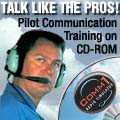Advertisers
       
Got news? Contact ePilot. Having difficulty using this service? Visit the ePilot Frequently Asked Questions now at AOPA Online or write to [email protected].
Aircraft Owners and Pilots Association
421 Aviation Way
Frederick, MD 21701
Tel: 800/USA-AOPA or
301/695-2000
Copyright � 2002 AOPA. | GA News
| PRESIDENTIAL PROTECTIONS CONTINUE TO CAUSE CONCERN
As most pilots now clearly understand, the FAA establishes temporary flight restrictions (TFRs) throughout the country, typically applying to small geographic areas and lasting for brief periods of time, to protect presidential movements. Although the practice predates the events of September 11, the enforcement of these is critical. New requirements have been added. For example, during Vice President Cheney’s Christmas stay in Jackson, Wyoming, all aircraft within 50 miles were required to obtain discrete transponder codes. Fighters intercepted several VFR aircraft that squawked 1200 instead of an assigned code. Two specific TFR areas that change frequently and should be closely monitored by pilots are P-49, the prohibited area over the Crawford Ranch in Texas, and P-40, which overlies Camp David in Maryland. Unfortunately, numerous recent incursions in both of these prohibited areas are raising FAA and national security community concerns, and could compromise the rights enjoyed by the entire general aviation community. AOPA reminds pilots to obtain current notams before every flight, even local flights. Pilots who violate these TFRs can expect to face certificate revocation as well as civil penalties.
SPORT PILOT NPRM EXPECTED NEXT WEEK
FAA sources tell AOPA that the long-anticipated Sport Pilot-Light Sport Aircraft proposed rule will "hit the streets" next week, barring any last-minute glitches. The FAA will publish a notice of proposed rulemaking (NPRM) to allow the public to comment on the rule. The proposal would regulate aircraft that are too large to be ultralights, but too small to economically meet current FAA certification standards. It also proposes a sport pilot certificate that could be obtained with about 20 hours of training and that would allow pilots to operate these aircraft with either a third class FAA medical certificate or a valid driver's license. "AOPA congratulates the Experimental Aircraft Association on�its efforts in working with the FAA and the industry to obtain the release of this proposal,"� said AOPA President Phil Boyer.�"AOPA��applauds any initiative that serves to lower the cost of learning to fly, and the continuing enjoyment of flight activity. The association will carefully evaluate each provision of the proposed rule once it becomes public, and will offer comments to ensure that safety is not compromised while maintaining a reasoned approach to sport aircraft and pilot certification." AOPA will post the rule on� AOPA Online�as soon as it becomes public and will provide a message area so that members can send their comments on the proposal directly to the FAA.
CANADA'S ATC FIRM HAS REVENUE SHORTFALL
Nav Canada, the private firm that handles Canada's air traffic control, electronic aids to navigation, and weather briefing needs, has announced it has revenue shortfalls of $145 million because of significant declines in actual and projected traffic. Company officials have eliminated a temporary discount on air navigation service charges as a result of the revenue problem. Additional measures to address the problem include $85 million in cost reductions and a drawdown of the remaining $30 million from the company's rate stabilization fund. Nav Canada will offer customers the option of a payment deferral plan, on a temporary basis, to help carriers manage their cash flow during the current industry turndown.
WRIGHT FLYER REPLICA MAY TEST AT EDWARDS AFB
Edwards Air Force Base, scene of flight tests for some of the nation's hottest new aircraft, may be used for flight tests of a Wright Flyer replica. Engineers from the American Institute of Aeronautics and Astronautics (AIAA) in Los Angeles are talking with their counterparts at NASA's Dryden Flight Research Center about flying a replica of the Wright Brothers' first powered airplane at Dryden's facility on Edwards Air Force Base in California's Mojave Desert. With a cruise speed of less than 30 knots, it won't be the hottest thing on the runway, but it will draw the most attention. It may be the most difficult to fly of most of the aircraft previously tested there. Last year, pilots and engineers found they could barely control a simulator programmed to fly with the characteristics of the Wright Flyer (see AOPA Online). Testing could occur by mid-2002.
GYROPLANE JOINS OLYMPIC SECURITY FORCE
 The Utah Olympic Public Safety Command (UOPSC) will be using a Hawk 4 Gyroplane for aerial observation during the Winter Olympics to provide additional security for the Salt Lake City International Airport and surrounding area. The aircraft, built by Groen Brothers Aviation, will be equipped with a forward-looking infrared day/night observation system, searchlight, microwave video downlink system, and law enforcement communications radios. It is expected to begin service with UOPSC on January 20. James P. Mayfield, Groen Brothers' chief operating officer, said that government agencies can either purchase the aircraft outright, or the company can provide an operational lease that includes the flight and observation crews. The Hawk 4, currently undergoing FAA certification, combines airplane operating costs with the off-runway operating capability of a helicopter. For more information see the Web site. The Utah Olympic Public Safety Command (UOPSC) will be using a Hawk 4 Gyroplane for aerial observation during the Winter Olympics to provide additional security for the Salt Lake City International Airport and surrounding area. The aircraft, built by Groen Brothers Aviation, will be equipped with a forward-looking infrared day/night observation system, searchlight, microwave video downlink system, and law enforcement communications radios. It is expected to begin service with UOPSC on January 20. James P. Mayfield, Groen Brothers' chief operating officer, said that government agencies can either purchase the aircraft outright, or the company can provide an operational lease that includes the flight and observation crews. The Hawk 4, currently undergoing FAA certification, combines airplane operating costs with the off-runway operating capability of a helicopter. For more information see the Web site.
For daily news updates, see AOPA Online.
| Squawk Sheet
| FAA ISSUES CONTINENTAL IO-360 BULLETIN
This week the FAA issued a Special Airworthiness Information Bulletin (SAIB) on Teledyne Continental Motors (TCM) IO-360 engines recommending inspection of the starter adapter bevel gear. SAIBs are advisory in nature and not mandatory. However, the FAA is advising owners to complete the inspections within the next 25 flight hours. The suspect gears were installed in certain starter assemblies purchased from TCM between August 1998 and the present. They were also sold individually as service spares during that same period. For a copy of the SAIB and the related TCM service bulletin, visit AOPA Online.
AOPA OPPOSES AEROSTAR AD PROPOSAL
This week AOPA submitted comments opposing a proposed airworthiness directive on various model Aerostar airplanes. The proposed AD mandates replacement of Roto-Master and Rajay scavenge pumps with Aerostar scavenge pumps within 50 hours time-in-service (TIS) to prevent failure of the scavenge pumps, possible loss of engine oil, and possible loss of engine power. In its comments, AOPA noted that Aerostar owners and operators have used their scavenge pumps for thousands of hours without incident, and the FAA Service Difficulty Report Database contains no reports of worn, damaged, or failed scavenge pumps installed on Aerostar airplanes. Members of the Aerostar Owners Association and the manufacturer of the suspect pumps also oppose this AD. For more information, see AOPA Online.
| Inside AOPA
| AOPA DEFENDS GA IN 'USA TODAY'
AOPA countered an editorial in the December 31 USA Today with a sharply worded opinion piece of its own. "A drastic increase in security at small general aviation airports is unnecessary," said the AOPA response, signed by AOPA President Phil Boyer. "Congress, the Department of Transportation, the Federal Aviation Administration, and the aviation community support this premise. So what does 'USA Today' know that these people don't?" For more information, see AOPA Online.
AOPA OPPOSES HIGHER CLASS B IN CINCINNATI
The FAA has finally released the much-anticipated notice of proposed rulemaking modifying Cincinnati's Class B airspace. While the FAA notice eliminates portions of the current Cincinnati/Northern Kentucky International Airport Class B airspace over Clermont County Airport, it raises the ceiling of the Cincinnati Class B airspace from 8,000 feet msl to 10,000 feet msl. "After a multiyear effort that began shortly after the November 1998 release of the final rule creating the Cincinnati Class B airspace, the FAA has given back airspace that was not needed to support Class B operations," said Melissa Bailey, AOPA vice president of air traffic services. "Unfortunately, this positive step is accompanied by an unjustified increase in the airspace ceiling that impacts general aviation overflights." AOPA will support the "cut-out" for Clermont and oppose the raising of the Class B ceiling.
Changing your mailing or e-mail addresses? Click here to update.
| On Capitol Hill
| CONGRESS HAS MORE TO DO FOR GA
When the congressional recess ends in late January, the highest priorities for AOPA Legislative Affairs will be to work with Congress for passage of a GA relief package, to see the Chicago airports bill preserving Meigs Field signed into law, to continue working on comprehensive airport land use legislation, and to advance AOPA's priorities in FAA spending, as well as begin work on the new FAA reauthorization act. The current act, AIR-21, will authorize funding for federal aviation programs through 2003 to the sum of $40 billion. See AOPA Online.
| Airport Support Network
| NEW YEARS RESOLUTIONS
It's not too late to consider the following new year's resolutions that will benefit your local GA airport:
• Find out if your airport has an ASN volunteer. If so, contact him or her, find out what they do, and offer to help. If there isn't one, consider nominating yourself or another AOPA member to fill that position.
• Contact the airport management and find out when it has public meetings. Make an effort to attend as many as possible this year. If you have questions about what happens at the meetings, ask–and verify your answers with AOPA.
• Review your airport's noise abatement procedures and resolve to follow them as much as safety allows. If you don't have noise abatement procedures, look at how you operate on and around the airport and see what you can do to keep airport noise within the airport. Some ideas are declining an intersection takeoff and using the full runway length, making a slight turn after departure to avoid the housing development off the end of the runway, reducing power as soon as safely possible per the POH/manufacturer's instructions, and pushing the propeller control forward on short final instead of the base to final turn. Fly friendly.
To learn more about the Airport Support Network, visit AOPA Online.
| AOPA Air Safety Foundation News
| ASF REPORTS MIDAIRS DECREASED LAST YEAR
Each month the AOPA Air Safety Foundation analyzes accident statistics and compares them with accidents from the previous year. The numbers are in for 2001, through the end of November. During the first 11 months of last year, there were 1,629 general aviation accidents--down 6.5 percent from last year's 1,743. And although the number of instructional GA accidents went up from 239 to 254, the number of fatalities decreased. It appears that ASF's campaign to reduce the number of midair collisions is having a positive impact, as the number of midairs decreased from 19 to 7–a 63.2 percent improvement! The complete monthly GA statistical reports are on AOPA Online. Download more information about accident statistics and analyses in the annual Nall Report.
| Quiz Me!
| Here’s a question asked by an AOPA member last week of our AOPA technical specialists. Test your knowledge.
Question: I've always found the numbering system for notams to be confusing. Can you explain the numbering scheme?
Answer: According to the FAA, each of the three notam types has its own numbering system. FDC notams are organized by year and then a computer-selected number--simply the next one on the list to get picked. For a notam D, the first two digits represent the month in which it was issued and the next set of numbers represent how many notams were issued for that month. There is no uniform system for notam Ls; it's up to the local airport to decide what number to put into the system. For more information on notams, see the Aeronautical Information Manual on AOPA Online.
Got a technical question for AOPA specialists? Call 800/872-2672 or e-mail to [email protected]. Send comments on our Quiz Me! questions to [email protected].
| Picture Perfect
| Jump to the AOPA Online Gallery to see the featured airplane of the day. Click on the link for details on how to capture wallpaper for your work area. See AOPA Online.
| What's New At AOPA Online
| AOPA HOME PAGE GETS NEW LOOK
AOPA Online's home page has a fresh new look. In addition, navigation has been enhanced with buttons featuring pop-up menus on the left side and top of the page, helping you to select more easily from among AOPA's many online resources. Try it for yourself.
INSTRUMENT APPROACH PROCEDURES UPDATED
The U.S. terminal procedures in AOPA's Online Airport Directory were updated on December 27, the effective date of the current National Aeronautical Charting Office instrument approach procedures, arrival and departure procedures, and airport diagrams. These procedures are current through February 21.
| ePilot Calendar
| Check your weekend weather on AOPA Online.
WEEKEND FLYING DESTINATIONS
East Lansing, Michigan. The Great Lakes International Aviation Conference takes place January 18 through 20 at the Kellogg Hotel and Conference Center. Call 517/335-9880 for event information.
For more airport details, see AOPA's Airport Directory Online . For more events, see Aviation Calendar of Events
ASF FLIGHT INSTRUCTOR REFRESHER CLINICS
(All clinics start at 7:30 a.m.)
The next AOPA Air Safety Foundation Flight Instructor Refresher Clinics are in Jacksonville, Florida, and Detroit, Michigan, January 12 and 13. For the Flight Instructor Refresher Clinic schedule, see AOPA Online.
ASF PINCH-HITTER GROUND-SCHOOL COURSES
(Pinch-Hitter courses start at 9:30 a.m.)
The next Pinch-Hitter� Ground School will take place January 6 in Long Beach, California, and San Antonio, Texas; and on February 3 in Dallas, Texas. For more Pinch-Hitter courses, see AOPA Online.
ASF SAFETY SEMINARS
AOPA Air Safety Foundation Safety Seminars are scheduled in California: Oakland, January 7; Santa Rosa, January 8; Sacramento, January 9; Fresno, January 10; Van Nuys, January 14; Ontario, January 15; Carlsbad, January 16; and Costa Mesa, January 17. The topic is "Spatial Disorientation." See AOPA Online.
For comments on calendar items or to make submissions, contact Julie S. Walker at [email protected].
| |